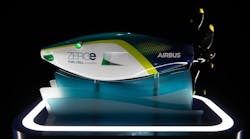By John McHale
COLORADO SPRINGS, Colo. — Engineers at Aeroflex UTMC developed a field programmable gate array (FPGA) that is radiation hardened for manned and unmanned space applications.
The UT4090 rad-hard FPGA has 90,000 usable programmable logic device (PLD) gates, data path speeds as fast as 200 MHz, embedded static random access memory (SRAM), and complies with the QML class-Q and class-T standards.
"Current and next-generation satellite avionics and payloads need high-performance, deep sub-micron design solutions and options, particularly programmable logic with soft and hard IP cores," says Anthony Jordan, director of standard products for Aeroflex UTMC, which he adds is responding with rad-hard solutions adapted from the commercial world.
"The UT4090 is Class-Q and -T certified," Jordan says. "Aeroflex UTMC's goal with Class T is to rapidly inject leading-edge, high-performance, commercial product into the space community. Our new partnership with QuickLogic continues our commitment to bring leading edge technology to the space community."
Jordan says his company's latest rad-hard offering is its sixth Class-T product since experts from the Defense Supply Center-Columbus (DSCC) certified UTMC for Class-T 15 months ago.
The reprogrammability of FPGAs is particularly appropriate for the avionics control systems of spacecraft, Jordan says. The increasing gate count of FPGAs also will enable space systems designers to put increasing amounts of intellectual property into an ever-shrinking space, he adds.
"The UT4090 is just the first of many rad-hard FPGA products to come from Aeroflex UTMC, he continues. "We'll follow the 0.35 [micron] product with a 0.25 [micron] CMOS technology within the next 18 months."
While UTMC's chip fab manufactures the part on a commercial line, Aeroflex UTMC engineers use proprietary design techniques to alleviate single-event latchup and single-event upset (SEU), which can hobble commercial parts radiation environments, company officials say.
The new device can withstand total-dose radiation of 30 kilorads tested to MIL-STD-883 Method 1019. An Aeroflex UTMC designed flip-flop eliminates the need for triple-mode redundancy, company officials say. The SEU target is no more than one upset every 15 years, Jordan says.
Aeroflex UTMC experts are using licensed Embedded Standard Products technology from QuickLogic in Sunnyvale, Calif., for the UT4090. Software support for the UT4090 is available from the QuickLogic QuickWorks package. QuickWorks provides an integrated framework supporting design entry via schematic capture, VHDL or Verilog, HDL synthesis, simulation, static timing analysis, and place and route.
The Aeroflex UTMC part interfaces with 3.3- and 5-volt devices, and is PCI compliant with 3.3 volt and 5-volt buses. Advanced I/O capabilities include JTAG boundary scan and registered I/O cells with individually controlled clocks and output enables, Aeroflex UTMC officials say.
The UT4090's 90,000 usable PLD gates are organized as 1,584 logic cells. In addition, 22 dual-port RAM modules provide 25,000 bits of dedicated SRAM in a variety of configurations for FIFO, RAM, and ROM functions, Aeroflex UTMC officials say. Designers can cascade several different RAM modules to increase the depth or width allowed in single modules.
For more information on the UT4090 and Aeroflex UTMC contact Teresa Farris by phone at 719-594-8035, by fax at 719-594-8468, by mail at Aeroflex UTMC, 4350 Centennial Blvd., Colorado Springs, Colo. 80907, by e-mail at [email protected], or on the World Wide Web at http://www.utmc.com.


